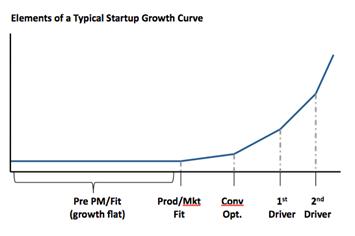I’m very excited about this guest post and confident that it will be a huge help for anyone struggling to find Product-Market fit. Enjoy! Sean
Guest Post By Patrick Vlaskovits
Sean asked me to write a guest post to help startups achieve Product-Market Fit since he primarily advises startup after they’ve already reached it (during their transition to high growth businesses). Actually getting to Product-Market Fit is an important topic since the vast majority of startups never get there, making it virtually impossible to drive sustainable growth.
I’ve just completed what amounts to a comprehensive study on the topic of getting to Product-Market Fit with Brant Cooper, culminating in our book called The Entrepreneur’s Guide to Customer Development. The most important insights were gained from successful serial entrepreneur, Steve Blank, who encouraged us to write the book as a primer to the first step of Customer Development. Customer Development is the startup framework he codified in his landmark book, The Four Steps to the Epiphany. If you haven’t read the book (you really should), Steve’s many insights are deep, but the core takeaway is that most startups fail not because they don’t manage to develop and deliver a product to the market; they fail because they develop and deliver a product that no customers want or need. The ramifications of this deceptively simple observation are manifold and underpin much of what you will read below. Sean has provided a free survey that should be helpful in validating if you have created a product people want or need.
The Entrepreneur’s Guide to Customer Development also folds in the work of Eric Ries. Eric has built upon Steve’s work and expanded it with his concept of “The Lean Startup.” A Lean Startup is one that combines fast-release, iterative development methodologies (e.g., Agile) with Customer Development concepts.
Wherever you are in the process of taking your product to market, the following Lean Startup and Customer Development concepts can help you achieve Product-Market Fit. Nothing else really matters to a startup other than getting to Product-Market Fit as fast as possible. Below is a brief outline, based on The Entrepreneur’s Guide to Customer Development, which will hopefully help you do just that.
Identify and document your assumptions
The sooner you understand and accept that you, as a entrepreneur at somewhere pre-Product Market Fit with your startup, are operating in near-chaos, where all your assumptions/hypotheses about how you gratify your users, who they are, how you will acquire and monetize them – are simply that, untested assumptions, the better off you are.
With your assumptions documented and in-hand you will:
“Get out of the Building” to validate (or invalidate) your assumptions
You must find, meet and speak with prospective customers about your product and ascertain the validity of your assumptions. This is the crux of Customer Development. Only by speaking to these people will you have any sort of understanding about “their reality” as Dan Martell likes to put it. What problems do they face? How do they solve them? What matters to them? What is a must-have for them?
As you speak to potential customers, you should:
Identify the risk factors in the opportunity
Are you facing significant technology risks? Or more of market risk? How can you test and validate these (starting with the most risky)? What market testable milestones can you build that would result in sufficient evidence to induce you to pivot or move forward? A proof of concept? A letter of intent? A prototype?
As your understanding of the market betters, the risks will begin to crystallize, if certain risk factors prove insurmountable, you must:
Pivot but not jump
By changing an element of your customer-problem-solution hypotheses or business model, based on actual learning from a customer. As Eric Ries writes “by testing, each failed hypothesis leads to a new pivot, where we change just one element of the business plan (customer segment, feature set, positioning) – but don’t abandon everything we’ve learned.
The way to test and learn from your market is to build an:
MVP (Minimal Viable Product)
Don’t forget that an MVP is a product with the fewest set of features needed to achieve a specific objective and that you should require a trade of some scarce resource (time, money, attention) for the use of the product, such that the transaction demonstrates the product might be “viable”.
For non-paying milestones, you must define the currency (the scarce resource) and your objective (what you are trying to learn). For example, intermediate MVPs might include: landing page click-through that prove there’s some amount of interest in a product; a time commitment for an in-person meeting to view a demo that shows the customer’s problem being resolved; or a resource commitment for a pilot program to test how the product fits into a particular environment.
Once you have users using your MVP, listen for and tune into the:
Must-have signal
that demonstrates the core product functionality that your customers absolutely must have, while testing your assumptions and learning the characteristics of your market segment that will allow you to reach out and acquire them efficiently. Sean’s survey, mentioned earlier, can be useful in finding your must have signal.
Once you successfully developed a minimal viable product and have found the must have signal, it is time to:
Double-down and strip away the unnecessary
Now you know what your customers want, you need to focus with laser-like intensity in building a gratification engine that does not disappoint.
If you can do all of the above successfully and throw in a hearty amount of luck for good measure, there is a good chance you can get to Product-Market Fit. It may take a significant amount of time and persistence, but potential customers always hold the answer to creating a must have product.


 Andrew Chen
Andrew Chen Brant Cooper
Brant Cooper Dave McClure
Dave McClure Eric Ries
Eric Ries Jamie Siminoff
Jamie Siminoff Steve Blank
Steve Blank